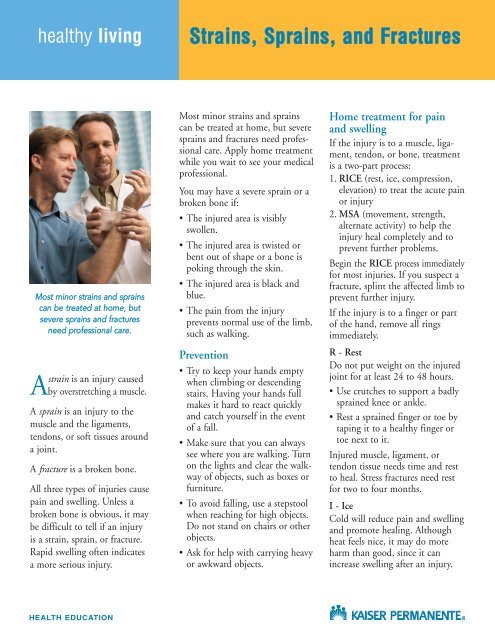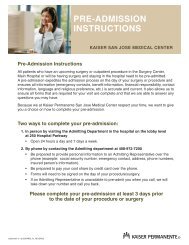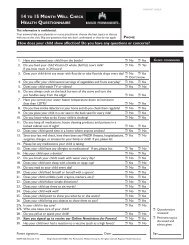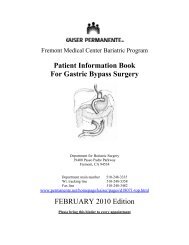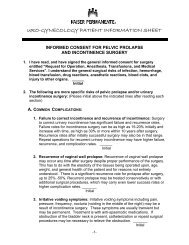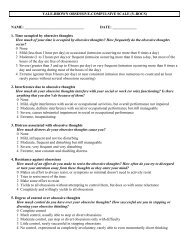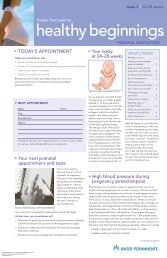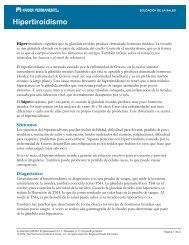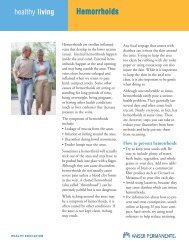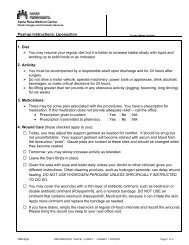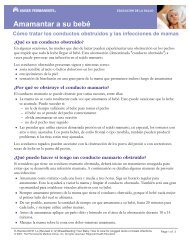Strains, Sprains, and Fractures - permanente.net
Strains, Sprains, and Fractures - permanente.net
Strains, Sprains, and Fractures - permanente.net
You also want an ePaper? Increase the reach of your titles
YUMPU automatically turns print PDFs into web optimized ePapers that Google loves.
healthy living<br />
<strong>Strains</strong>, <strong>Sprains</strong>, <strong>and</strong> <strong>Fractures</strong><br />
Most minor strains <strong>and</strong> sprains<br />
can be treated at home, but<br />
severe sprains <strong>and</strong> fractures<br />
need professional care.<br />
Astrain is an injury caused<br />
by overstretching a muscle.<br />
A sprain is an injury to the<br />
muscle <strong>and</strong> the ligaments,<br />
tendons, or soft tissues around<br />
a joint.<br />
A fracture is a broken bone.<br />
All three types of injuries cause<br />
pain <strong>and</strong> swelling. Unless a<br />
broken bone is obvious, it may<br />
be difficult to tell if an injury<br />
is a strain, sprain, or fracture.<br />
Rapid swelling often indicates<br />
a more serious injury.<br />
Most minor strains <strong>and</strong> sprains<br />
can be treated at home, but severe<br />
sprains <strong>and</strong> fractures need professional<br />
care. Apply home treatment<br />
while you wait to see your medical<br />
professional.<br />
You may have a severe sprain or a<br />
broken bone if:<br />
• The injured area is visibly<br />
swollen.<br />
• The injured area is twisted or<br />
bent out of shape or a bone is<br />
poking through the skin.<br />
• The injured area is black <strong>and</strong><br />
blue.<br />
• The pain from the injury<br />
prevents normal use of the limb,<br />
such as walking.<br />
Prevention<br />
• Try to keep your h<strong>and</strong>s empty<br />
when climbing or descending<br />
stairs. Having your h<strong>and</strong>s full<br />
makes it hard to react quickly<br />
<strong>and</strong> catch yourself in the event<br />
of a fall.<br />
• Make sure that you can always<br />
see where you are walking. Turn<br />
on the lights <strong>and</strong> clear the walkway<br />
of objects, such as boxes or<br />
furniture.<br />
• To avoid falling, use a stepstool<br />
when reaching for high objects.<br />
Do not st<strong>and</strong> on chairs or other<br />
objects.<br />
• Ask for help with carrying heavy<br />
or awkward objects.<br />
Home treatment for pain<br />
<strong>and</strong> swelling<br />
If the injury is to a muscle, ligament,<br />
tendon, or bone, treatment<br />
is a two-part process:<br />
1. RICE (rest, ice, compression,<br />
elevation) to treat the acute pain<br />
or injury<br />
2. MSA (movement, strength,<br />
alternate activity) to help the<br />
injury heal completely <strong>and</strong> to<br />
prevent further problems.<br />
Begin the RICE process immediately<br />
for most injuries. If you suspect a<br />
fracture, splint the affected limb to<br />
prevent further injury.<br />
If the injury is to a finger or part<br />
of the h<strong>and</strong>, remove all rings<br />
immediately.<br />
R - Rest<br />
Do not put weight on the injured<br />
joint for at least 24 to 48 hours.<br />
• Use crutches to support a badly<br />
sprained knee or ankle.<br />
• Rest a sprained finger or toe by<br />
taping it to a healthy finger or<br />
toe next to it.<br />
Injured muscle, ligament, or<br />
tendon tissue needs time <strong>and</strong> rest<br />
to heal. Stress fractures need rest<br />
for two to four months.<br />
I - Ice<br />
Cold will reduce pain <strong>and</strong> swelling<br />
<strong>and</strong> promote healing. Although<br />
heat feels nice, it may do more<br />
harm than good, since it can<br />
increase swelling after an injury.<br />
HEALTH EDUCATION
healthy living<br />
<strong>Strains</strong>, <strong>Sprains</strong>, <strong>and</strong> <strong>Fractures</strong><br />
Apply cold packs immediately to<br />
prevent or minimize swelling. You<br />
can also put ice cubes in a plastic<br />
bag <strong>and</strong> wrap it with a thin towel<br />
before applying to your injury. For<br />
difficult-to-reach injuries, a cold<br />
pack works best.<br />
C - Compression<br />
Wrap the injury with an elastic<br />
(Ace) b<strong>and</strong>age or compression<br />
sleeve to immobilize <strong>and</strong> compress<br />
the sprain. Don’t wrap it too tightly<br />
because this can cause more<br />
swelling. Loosen the b<strong>and</strong>age if it<br />
gets too tight. A tightly wrapped<br />
sprain may fool you into thinking<br />
you can keep using the joint.<br />
With or without a wrap, the joint<br />
needs total rest for one to two days.<br />
E - Elevation<br />
Elevate the injured area on pillows<br />
while you apply ice <strong>and</strong> anytime<br />
you are sitting or lying down.<br />
Try to keep the injury at or above<br />
the level of your heart to minimize<br />
swelling.<br />
• Aspirin, ibuprofen, naproxen, or<br />
Orudis may help ease inflammation<br />
<strong>and</strong> pain. Do not use<br />
drugs to mask the pain while<br />
you continue to use the injured<br />
joint. Do not give aspirin to<br />
children or teens under age 20.<br />
Review aspirin guidelines.<br />
• The use of heat (hot water<br />
bottle, warm towel, heating pad)<br />
after 48 hours of cold treatments<br />
is controversial. Some experts<br />
think heat will increase swelling;<br />
others think it may speed healing.<br />
If you use heat, do not<br />
apply anything that is uncomfortably<br />
warm.<br />
Begin the MSA process as soon as<br />
the initial pain <strong>and</strong> swelling have<br />
subsided. This may be in two days<br />
or up to a week or longer,<br />
depending on the location <strong>and</strong><br />
severity of the injury. Once pain<br />
<strong>and</strong> swelling subside, you can<br />
slowly resume sports <strong>and</strong> activities.<br />
Any increased pain may be<br />
a sign that you need to rest a<br />
while longer.<br />
M - Movement<br />
After one to two days of rest,<br />
begin moving the joint. Move<br />
your joint gently through its full<br />
range of motion. If an activity<br />
causes pain, stop <strong>and</strong> give the<br />
joint more rest. Gentle stretching<br />
will prevent scar tissue (formed as<br />
the injury heals) from limiting<br />
movement later.<br />
S - Strength<br />
Once the swelling is gone <strong>and</strong><br />
range of motion is restored, begin<br />
gradual efforts to strengthen the<br />
injured area. This may require<br />
specific exercises.<br />
A - Alternate activities<br />
After the first few days, but while<br />
the injured part is still healing,<br />
you can begin to phase in regular<br />
exercise that does not place strain<br />
on the injured part.<br />
Call Kaiser Permanente if . .<br />
• A bone is poking through the<br />
skin, or if a limb below the<br />
injury is white, cold, or numb.<br />
• You suspect a severe sprain or<br />
fracture. After you have stopped<br />
weight-bearing activities, splinted<br />
the injury, <strong>and</strong> applied ice, a<br />
short delay in receiving professional<br />
care will not affect the outcome.<br />
• A sprained joint is very unstable,<br />
won’t support your weight, or<br />
wobbles from side to side.<br />
• You cannot bear weight on a<br />
sprained ankle after 24 hours, or<br />
if it hurts to bear weight after<br />
three days.<br />
• Pain is still severe after two days<br />
of home treatment.<br />
• A sprain does not improve after<br />
four days of home treatment.<br />
Other resources<br />
• Connect to our Web site at kp.org<br />
to access health <strong>and</strong> drug encyclopedias,<br />
interactive programs,<br />
health classes, <strong>and</strong> much more.<br />
• Contact your Kaiser Permanente<br />
Health Education Center or<br />
Department for health information,<br />
programs, <strong>and</strong> other resources.<br />
This information is not intended to diagnose health problems or to take the place of medical advice or care you receive from your physician or other<br />
health care professional. If you have persistent health problems, or if you have additional questions, please consult with your doctor. If you have<br />
questions or need more information about your medication, please speak to your pharmacist. Kaiser Permanente does not endorse the medications<br />
or products mentioned. Any trade names listed are for easy identification only.<br />
© 2008, The Permanente Medical Group, Inc. All rights reserved. Regional Health Education.<br />
011061-199 (Revised 11-10) RL 7.2


